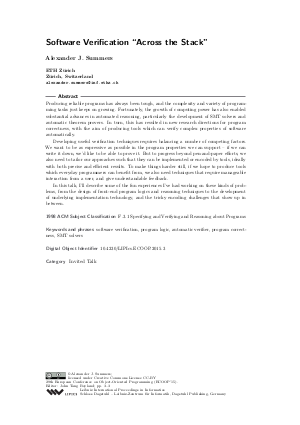Software Verification "Across the Stack" (Invited Talk)
Author Alexander J. Summers
-
Part of:
Volume:
29th European Conference on Object-Oriented Programming (ECOOP 2015)
Part of: Series: Leibniz International Proceedings in Informatics (LIPIcs)
Part of: Conference: European Conference on Object-Oriented Programming (ECOOP) - License:
 Creative Commons Attribution 3.0 Unported license
Creative Commons Attribution 3.0 Unported license
- Publication Date: 2015-06-29
File

PDF
LIPIcs.ECOOP.2015.3.pdf
- Filesize: 203 kB
- 1 pages
Document Identifiers
Subject Classification
Keywords
- software verification
- program logic
- automatic verifier
- program correctness
- SMT solvers
Metrics
- Access Statistics
-
Total Accesses (updated on a weekly basis)
0Document
0Metadata
Abstract
Producing reliable programs has always been tough, and the complexity and variety of programming tasks just keeps on growing. Fortunately, the growth of computing power has also enabled substantial advances in automated reasoning, particularly the development of SMT solvers and automatic theorem provers. In turn, this has resulted in new research directions for program correctness, with the aim of producing tools which can verify complex properties of software automatically. Developing useful verification techniques requires balancing a number of competing factors. We want to be as expressive as possible in the program properties we can support - if we can write it down, we'd like to be able to prove it. But to progress beyond pen-and-paper efforts, we also need to tailor our approaches such that they can be implemented or encoded by tools, ideally with both precise and efficient results. To make things harder still, if we hope to produce tools which everyday programmers can benefit from, we also need techniques that require manageable interaction from a user, and give understandable feedback. In this talk, I'll describe some of the fun experiences I've had working on these kinds of problems, from the design of front-end program logics and reasoning techniques to the development of underlying implementation technology, and the tricky encoding challenges that show up in between.
Cite As Get BibTex
Alexander J. Summers. Software Verification "Across the Stack" (Invited Talk). In 29th European Conference on Object-Oriented Programming (ECOOP 2015). Leibniz International Proceedings in Informatics (LIPIcs), Volume 37, p. 3, Schloss Dagstuhl – Leibniz-Zentrum für Informatik (2015)
https://doi.org/10.4230/LIPIcs.ECOOP.2015.3
BibTex
@InProceedings{summers:LIPIcs.ECOOP.2015.3,
author = {Summers, Alexander J.},
title = {{Software Verification "Across the Stack"}},
booktitle = {29th European Conference on Object-Oriented Programming (ECOOP 2015)},
pages = {3--3},
series = {Leibniz International Proceedings in Informatics (LIPIcs)},
ISBN = {978-3-939897-86-6},
ISSN = {1868-8969},
year = {2015},
volume = {37},
editor = {Boyland, John Tang},
publisher = {Schloss Dagstuhl -- Leibniz-Zentrum f{\"u}r Informatik},
address = {Dagstuhl, Germany},
URL = {https://drops.dagstuhl.de/entities/document/10.4230/LIPIcs.ECOOP.2015.3},
URN = {urn:nbn:de:0030-drops-52141},
doi = {10.4230/LIPIcs.ECOOP.2015.3},
annote = {Keywords: software verification, program logic, automatic verifier, program correctness, SMT solvers}
}
